Engine PONTIAC GRAND AM 2003 Owner's Manual
[x] Cancel search | Manufacturer: PONTIAC, Model Year: 2003, Model line: GRAND AM, Model: PONTIAC GRAND AM 2003Pages: 354, PDF Size: 16.3 MB
Page 126 of 354
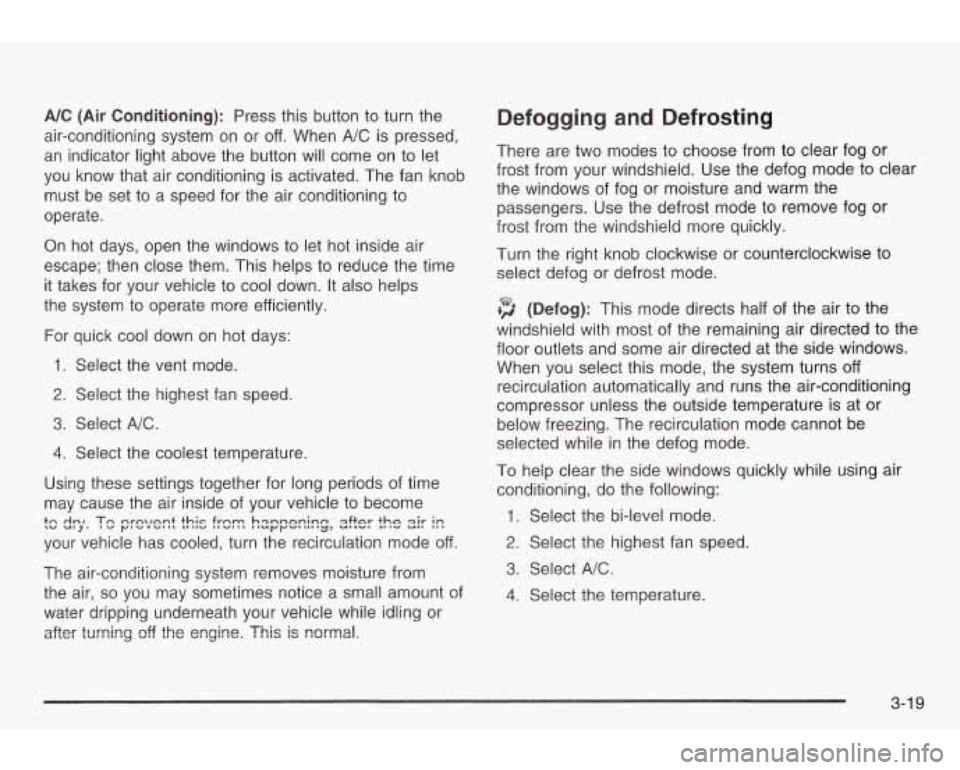
A/C (Air Conditioning): Press this button to turn the
air-conditioning system on or off. When
NC is pressed,
an indicator light above the button will come on
to let
you know that air conditioning is activated. The fan knob
must be set
to a speed for the air conditioning to
operate.
On hot days, open the windows
to let hot inside air
escape; then close them. This helps
to reduce the time
it takes for your vehicle to cool down. It also helps
the system
to operate more efficiently.
For quick cool down on hot days:
1. Select the vent mode.
2. Select the highest fan speed.
3. Select NC.
4. Select the coolest temperature.
Using these settings together for long periods of time
may cause the air inside of your vehicle
to become
your vehicle has cooled, turn the recirculation mode off
tc
dry. Tc prevent
this frcl?? hsppenin& s!?er the 2i!- i!7
The air-conditioning system removes moisture from
the air,
so you may sometimes notice a small amount of
water dripping underneath your vehicle while idling or
after turning
Gf! the engine. This is nCx??ml.
Defogging and Defrosting
There are two modes to choose from to clear fog or
frost from your windshield. Use the defog mode to clear
the windows of fog or moisture and warm the
passengers. Use the defrost mode
to remove fog or
frost from the windshield more quickly.
Turn the right knob clockwise or counterclockwise
to
select defog or defrost mode.
+3 (Defog): This mode directs half of the air to the
windshield with most of the remaining air directed
to the
floor outlets and some air directed at the side windows.
When you select this mode, the system turns
off
recirculation automatically and runs the air-conditioning
compressor unless the outside temperature is at or
below freezing. The recirculation mode cannot be
selected while in the defog mode.
To help clear the side windows quickly while using air
conditioning, do the following:
1. Select the bi-level mode.
2. Select the highest fan speed.
3. Select NC.
4. Select the temperature.
3-1 9
Page 127 of 354
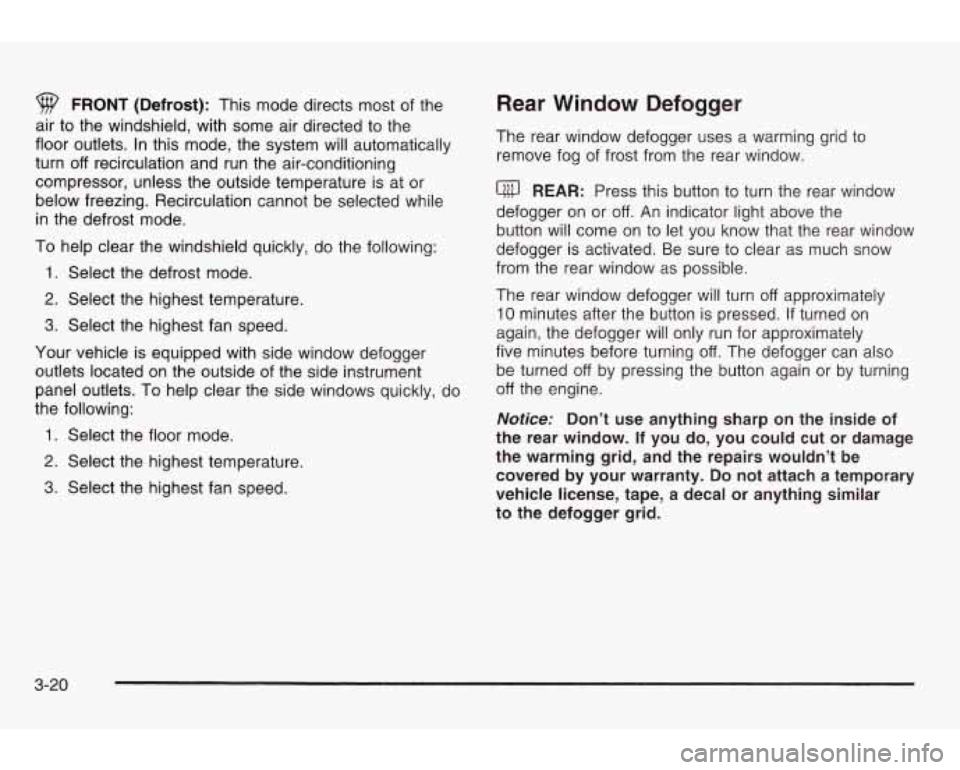
9 FRONT (Defrost): This mode directs most of the
air to the windshield, with some air directed to the
floor outlets. In this mode, the system will automatically
turn
off recirculation and run the air-conditioning
compressor, unless the outside temperature is at or
below freezing. Recirculation cannot be selected while
in the defrost mode.
To help clear the windshield quickly, do the following:
1. Select the defrost mode.
2. Select the highest temperature.
3. Select the highest fan speed.
Your vehicle is equipped with side window defogger
outlets located on the outside of the side instrument
panel outlets. To help clear the side windows quickly, do
the following:
1. Select the floor mode.
2. Select the highest temperature.
3. Select the highest fan speed.
Rear Window Defogger
The rear window defogger uses a warming grid to
remove fog of frost from the rear window.
REAR: Press this button to turn the rear window
defogger on or
off. An indicator light above the
button will come on to let you know that the rear window
defogger is activated. Be sure to clear as much snow
from the rear window as possible.
The rear window defogger will turn
off approximately
10 minutes after the button is pressed. If turned on
again, the defogger will only run for approximately
five minutes before turning
off. The defogger can also
be turned
off by pressing the button again or by turning
off the engine.
Notice: Don’t use anything sharp on the inside of
the rear window.
If you do, you could cut or damage
the warming grid, and the repairs wouldn’t be
covered by your warranty.
Do not attach a temporary
vehicle license, tape, a decal or anything similar
to the defogger grid.
3-20
Page 129 of 354
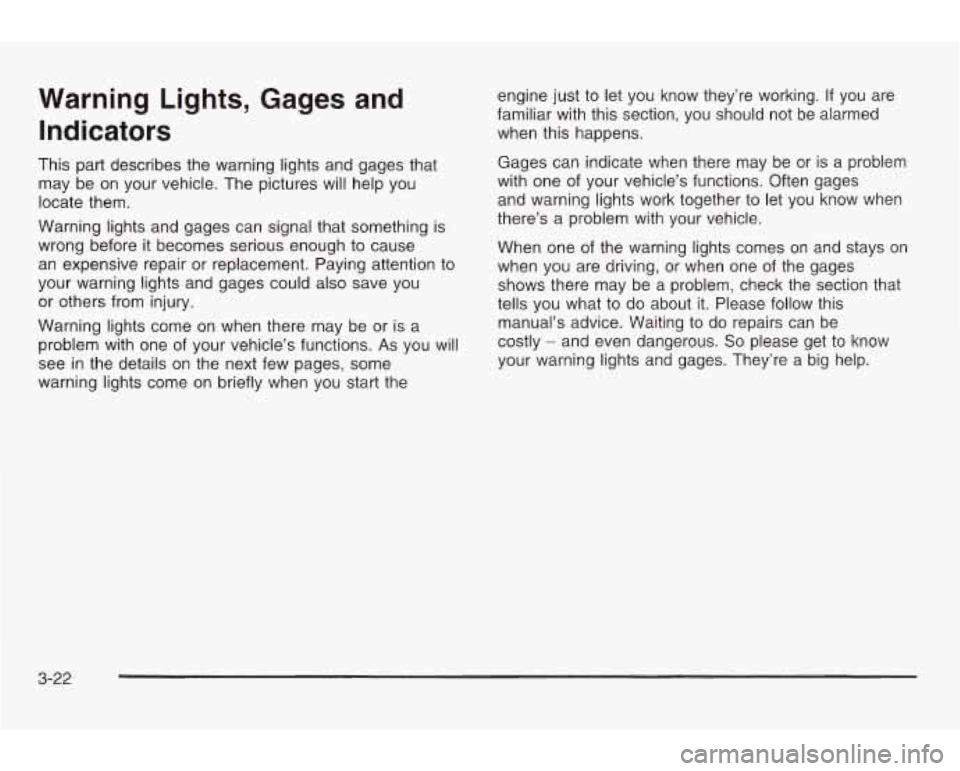
Warning Lights, Gages and Indicators
This part describes the warning lights and gages that
may be on your vehicle. The pictures will help you
locate them.
Warning lights and gages can signal that something is
wrong before it becomes serious enough to cause an expensive repair or replacement. Paying attention to
your warning lights and gages could also save you
or others from injury.
Warning lights come on when there may be or is a
problem with one of your vehicle’s functions.
As you will
see in the details on the next few pages, some
warning lights come on briefly when you start the engine just to let you
know they’re working. If you are
familiar with this section, you should not be alarmed
when this happens.
Gages can indicate when there may be or
is a problem
with one of your vehicle’s functions. Often gages
and warning lights work together to let you know when
there’s a problem with your vehicle.
When one of the warning lights comes on and stays
on
when you are driving, or when one of the gages
shows there may be a problem, check the section that
tells you what to
do about it. Please follow this
manual’s advice. Waiting
to do repairs can be
costly
- and even dangerous. So please get to know
your warning lights and gages. They’re a big help.
3-22
Page 131 of 354
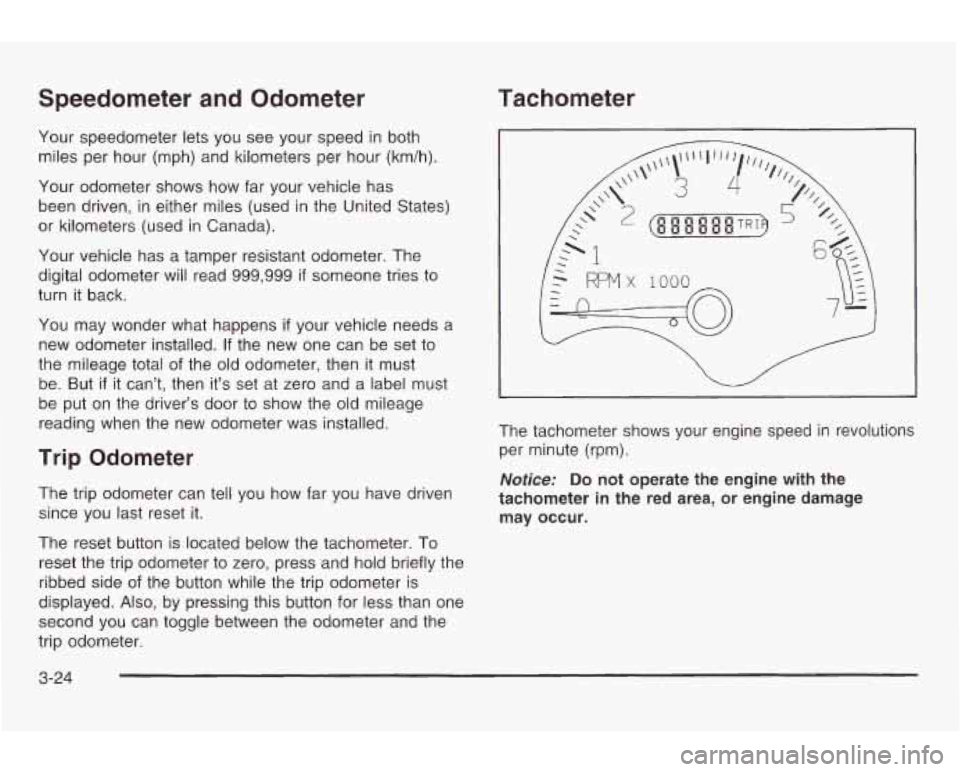
Speedometer and Odometer Tachometer
Your speedometer
lets you see your speed in both
miles per hour (mph) and kilometers per hour (km/h).
Your odometer shows how far your vehicle has
been driven, in either miles (used in the United States)
or kilometers (used in Canada).
Your vehicle has a tamper resistant odometer. The
digital odometer will read 999,999
if someone tries to
turn it back.
You may wonder what happens
if your vehicle needs a
new odometer installed. If the new one can be set
to
the mileage total of the old odometer, then it must
be. But
if it can’t, then it’s set at zero and a label must
be put on the driver’s door to show the old mileage
reading when the new odometer was installed.
Trip Odometer
The trip odometer can tell you how far you have driven
since you last reset it. The
tachometer shows your engine speed in revolutions
per minute
(rpm).
Notice: Do not operate the engine with the
tachometer in the red area,
or engine damage
may occur.
The reset button is located below the tachometer. To
reset the trip odometer
to zero, press and hold briefly the
ribbed side of the button while the trip odometer is
displayed.
Also, by pressing this button for less than one
second you can toggle between the odometer and the
trip odometer.
3-24
Page 133 of 354
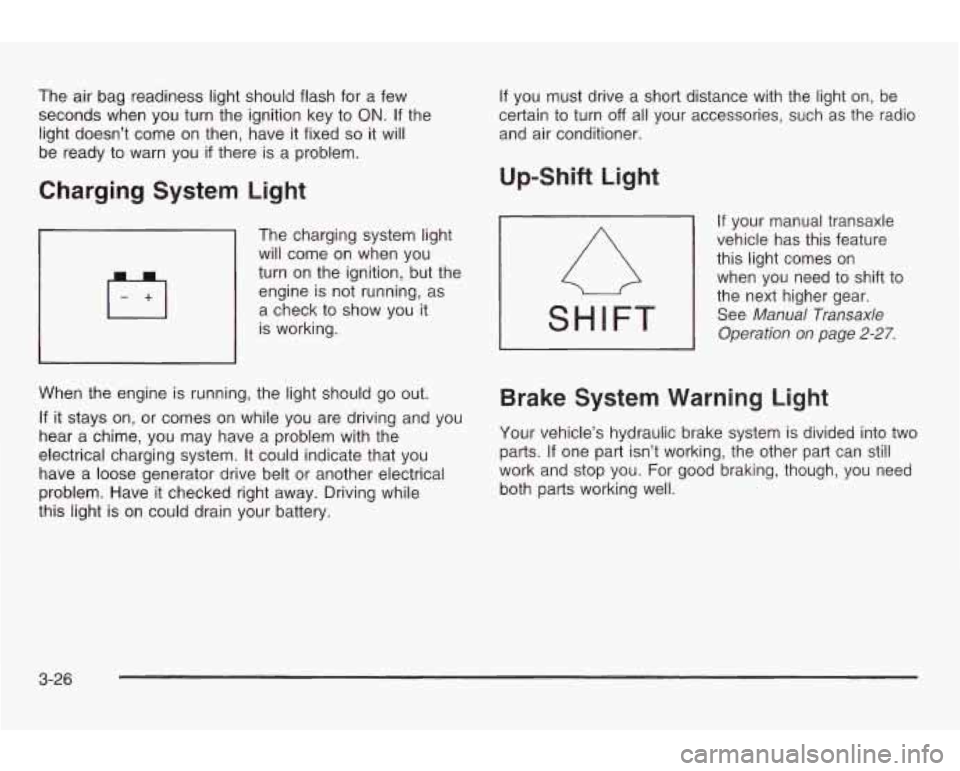
The air bag readiness light should flash for a few
seconds when you turn the ignition key to
ON. If the
light doesn’t come on then, have it fixed
so it will
be ready to warn you
if there is a problem.
Charging System Light
The charging system light
will come on when you
turn on the ignition, but the
II engine is not running, as
a check to show you
it
is working.
When the engine is running, the light should go out.
If it stays on, or comes on while you are driving and you
hear a chime, you may have a problem with the
electrical charging system. It could indicate that you have a loose generator drive belt or another electrical
problem. Have it checked right away. Driving while
this light is on could drain your battery. If
you must drive a short distance with the light on, be
certain to turn
off all your accessories, such as the radio
and air conditioner.
Up-Shift Light
If your manual transaxle
vehicle has this feature
this light comes on
when you need to shift to
the next higher gear.
See
Manual Transaxle
Operation on page
2-27.
Brake System Warning Light
Your vehicle’s hydraulic brake system is divided into two
parts. If one part isn’t working, the other part can still
work and stop you.
For good braking, though, you need
both parts working well.
3-26
Page 135 of 354

Anti-Lock Brake System
Warning Light
If your vehicle has the
anti-lock brake system, the
light will come on when
your engine is started and
may stay on for several
seconds. That’s normal.
If the light stays on, turn the ignition to OFF. Or, if the
light comes on when you’re driving, stop as soon
as possible and turn the ignition
off. Then start the
engine again to reset the system. If the light still stays
on, or comes on again while you’re driving, your vehicle
needs service. If the regular brake system warning
light isn’t on, you still have brakes, but you don’t have
anti-lock brakes. If the regular brake system warning
light is also on, you don’t have anti-lock brakes
and there’s a problem with your regular brakes. See
Brake System Warning Light on page 3-26 earlier in this
section.
The anti-lock brake system warning light will come on
briefly when you turn the ignition key
to ON. This is
normal.
If the light doesn’t come on then, have it fixed
so it will be ready to warn you if there is a problem.
Enhanced Traction System
Warning Light
TRAC
OFF
If your vehicle has the
Enhanced Traction System
(ETS), this warning light
should come on briefly as
you start the engine.
If the warning light doesn’t come on then, have it fixed
so it will be ready to warn you if there’s a problem.
If the warning light stays on, or comes on when you’re
driving, there may be a problem with your Enhanced
Traction System and your vehicle may need service.
When this warning light is on, the system will not
limit wheel spin. Adjust your driving accordingly.
3-28
Page 136 of 354
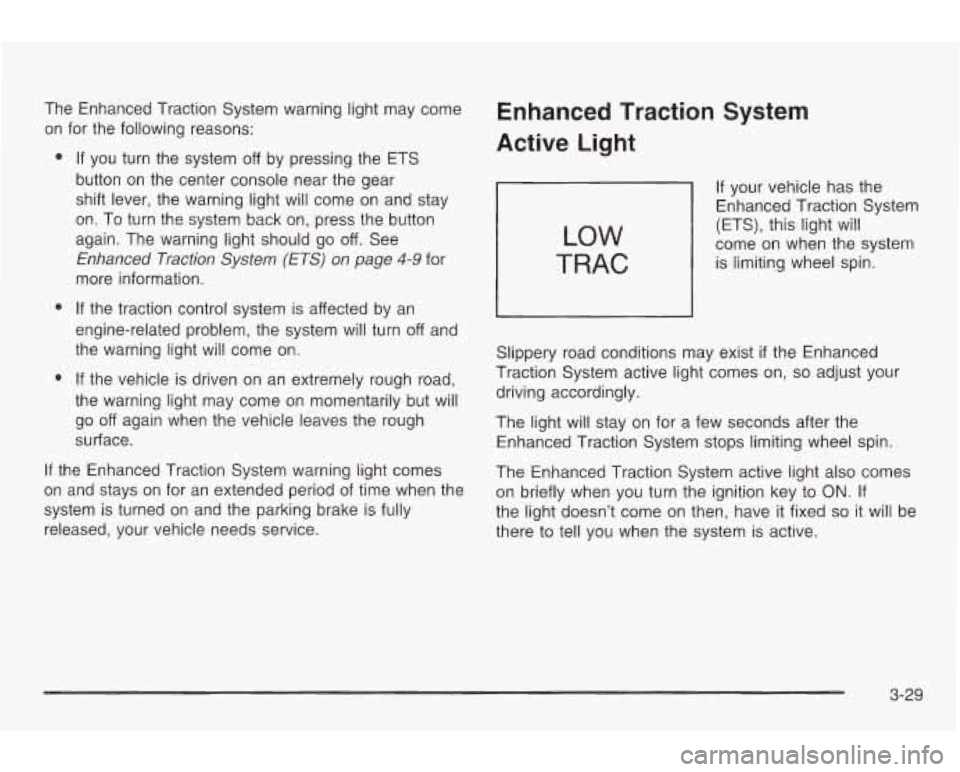
The Enhanced Traction System warning light may come
on for the following reasons:
0 If you turn the system off by pressing the ETS
button on the center console near the gear
shift lever, the warning light will come on and stay
on. To turn the system back on, press the button
again. The warning light should
go off. See
Enhanced Traction System (ETS) on page 4-9 for
more information.
0 If the traction control system is affected by an
engine-related problem, the system will turn
off and
the warning light will come on.
0 If the vehicle is driven on an extremely rough road,
the warning light may come on momentarily but will
go
off again when the vehicle leaves the rough
surface.
If the Enhanced Traction System warning light comes
on and stays on for an extended period of time when the
system is turned on and the parking brake is fully
released, your vehicle needs service.
Enhanced Traction System
Active Light
LOW
TRAC
If your vehicle has the
Enhanced Traction System
(ET§), this light
will
come on when the system
is limiting wheel spin.
Slippery road conditions may exist
if the Enhanced
Traction System active light comes
on, so adjust your
driving accordingly.
The light will stay on for a few seconds after the
Enhanced Traction System stops limiting wheel spin.
The Enhanced Traction System active light also comes on briefly when you turn the ignition key to
ON. If
the light doesn’t come on then, have
it fixed so it will be
there
to tell you when the system is active.
3-29
Page 137 of 354
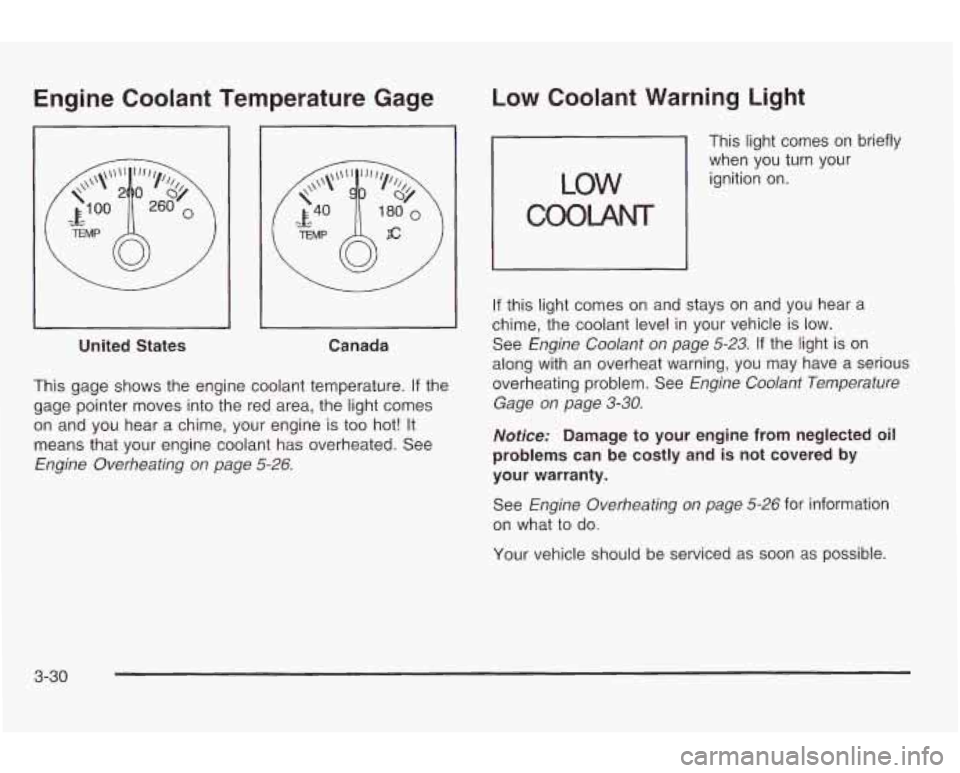
Engine Coolant Temperature Gage
L
United States Canada
This gage shows the engine coolant temperature.
If the
gage pointer moves into the red area, the light comes
on and you hear a chime, your engine is
too hot! It
means that your engine coolant has overheated. See
Engine Overheating on page 5-26.
Low Coolant Warning Light
This light comes on briefly
when you turn your
ignition on.
COOLANT
If this light comes on and stays on and you hear a
chime, the coolant level in your vehicle is
low.
See Engine Coolant on page 5-23. If the light is on
along with an overheat warning, you may have a serious
overheating problem. See
Engine Coolant Temperature
Gage on page
3-30.
Notice: Damage to your engine from neglected oil
problems can be costly and is not covered by
your warranty.
See
Engine Overheating on page 5-26 for information
on what
to do.
Your vehicle should be serviced as soon as possible.
3-30
Page 138 of 354
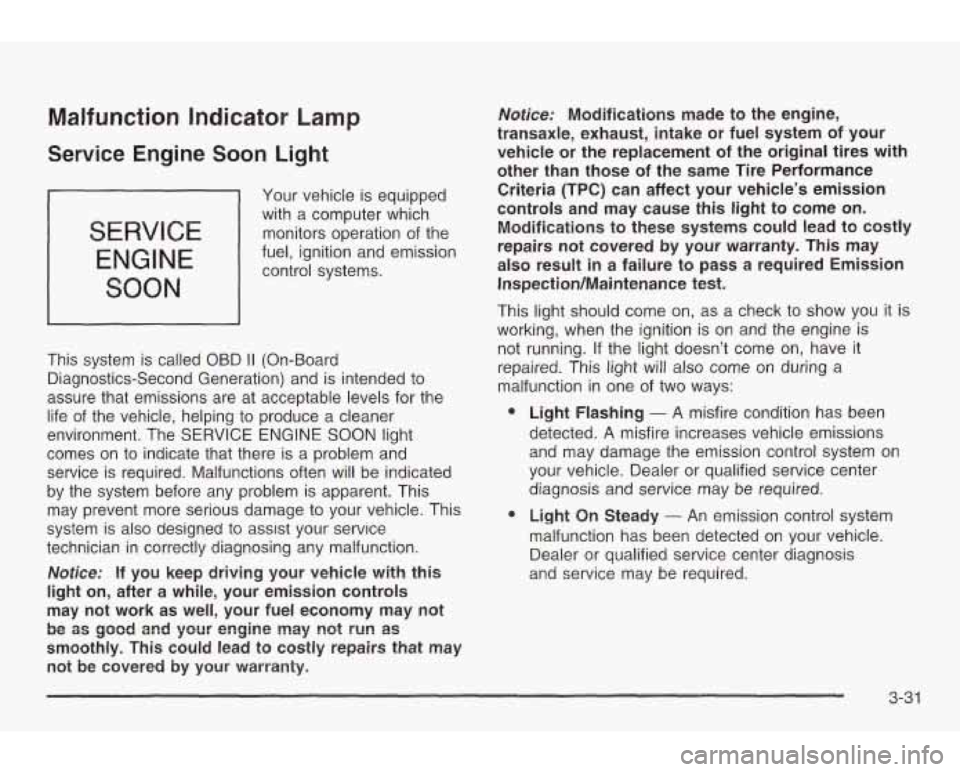
Malfunction Indicator Lamp
Service Engine Soon Light
SERVICE
ENGINE
SOON
Your vehicle is equipped
with a computer which
monitors operation of the
fuel, ignition and emission control systems.
This system is called OBD
II (On-Board
Diagnostics-Second Generation) and is intended to
assure that emissions are at acceptable levels for the
life of the vehicle, helping
to produce a cleaner
environment. The
SERVICE ENGINE SOON light
comes on to indicate that there is a problem and
service is required. Malfunctions often will be indicated
by the system before any problem
is apparent. This
may prevent more serious damage
to your vehicle. This
system is also designed to assist your service
technician in correctly diagnosing any malfunction.
Notice: If you keep driving your vehicle with this
light on, after a while, your emission controls
may not work as well, your fuel economy may not
smoothly. This could lead to costly repairs that may not be covered by your warramty.
be 85 gcod and yaur engine may not run as
Notice: Modifications made to the engine,
transaxle, exhaust, intake or fuel system of your
vehicle or the replacement of
the original tires with
other than those
of the same Tire Performance
Criteria
(TPC) can affect your vehicle’s emission
controls and may cause
this light to come on.
Modifications to these systems could lead to costly
repairs not covered &y your warranty. This may
also result in a failure to pass a required Emission
Inspection/Maintenance test.
This light should come on, as a check to show you
it is
working, when the ignition is on and the engine
is
not running. If the light doesn’t come on, have it
repaired. This light will also come on during
a
malfunction in one of two ways:
e
e
Light Flashing - A misfire condition has been
detected.
A misfire increases vehicle emissions
and may damage the emission control system
on
your vehicle. Dealer or qualified service center
diagnosis and service may be required.
Light On Steady
- An emission control system
malfunction has been detected on your vehicle.
Dealer or qualified service center diagnosis
and service may be required.
3-31
Page 139 of 354
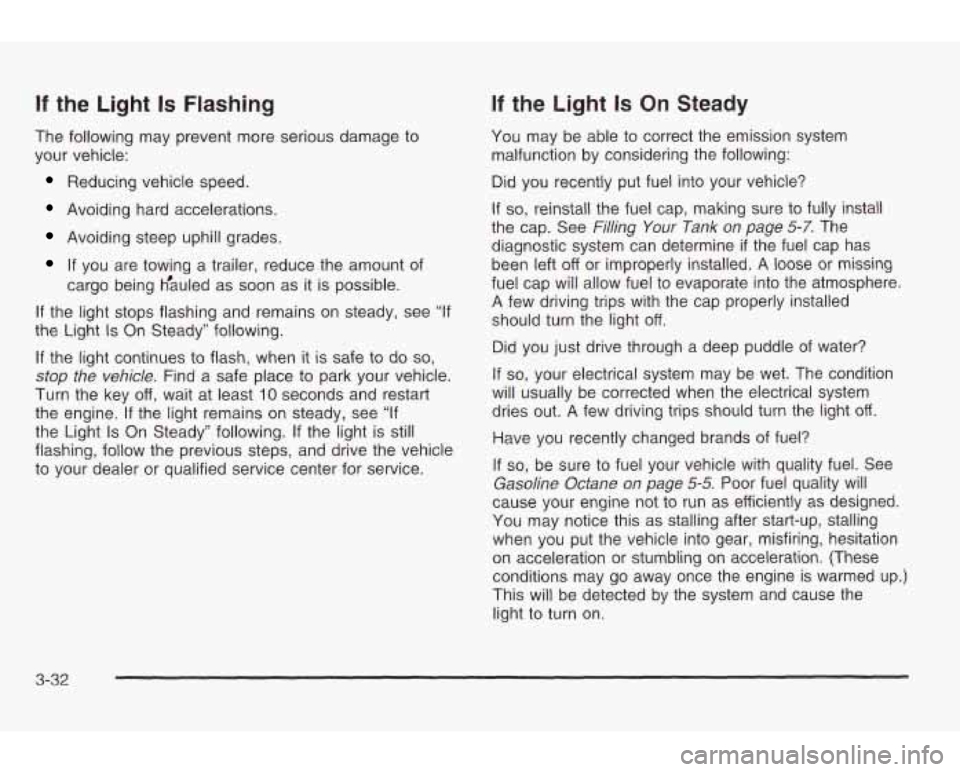
If the Light Is Flashing
The following may prevent more serious damage to
your vehicle:
Reducing vehicle speed.
Avoiding hard accelerations.
Avoiding steep uphill grades.
If you are towing a trailer, reduce the amount of
cargo being h%uled as soon as it
is possible.
If the light stops flashing and remains on steady, see “If
the Light
Is On Steady” following.
If the light continues to flash, when it is safe to do so,
stop the vehicle. Find a safe place to park your vehicle.
Turn the key
off, wait at least 10 seconds and restart
the engine.
If the light remains on steady, see “If
the Light Is On Steady” following. If the light is still
flashing, follow the previous steps, and drive the vehicle
to your dealer or qualified service center for service.
If the Light Is On Steady
You may be able to correct the emission system
malfunction by considering the following:
Did you recently put fuel into your vehicle?
If so, reinstall the fuel cap, making sure to fully install
the cap. See
Filling Your Tank on page 5-7. The
diagnostic system can determine
if the fuel cap has
been left
off or improperly installed. A loose or missing
fuel cap will allow fuel
to evaporate into the atmosphere.
A few driving trips with the cap properly installed
should turn the light
off.
Did you just drive through a deep puddle of water?
If
so, your electrical system may be wet. The condition
will usually be corrected when the electrical system
dries out. A few driving trips should turn the light
off.
Have you recently changed brands of fuel?
If
so, be sure to fuel your vehicle with quality fuel. See
Gasoline Octane on page 5-5. Poor fuel quality will
cause your engine not
to run as efficiently as designed.
You may notice this as stalling after start-up, stalling
when you put the vehicle into gear, misfiring, hesitation
on acceleration or stumbling on acceleration. (These
conditions may go away once the engine is warmed up.)
This will be detected by the system and cause the
light
to turn on.
3-32